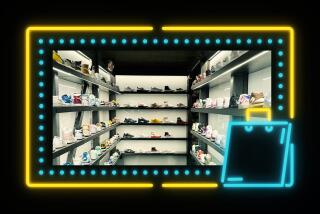Firm Sees a Way to Revolutionize Sign Business : Technology Born of Video Games
- Share via
Using technology inspired by computer video games, an Irvine-based company is bent on revolutionizing the sign- and banner-making industry.
Privately owned Banacom Manufacturing & Marketing Inc. already has sold its technology to more than 230 retail printing shops around the world. And under franchising plans now being completed, the company anticipates most of those operations will choose to convert to Banacom franchises this year. Each franchise would become a Banacom Instant Sign Center.
“We are where the instant printing industry was 15 years ago,” said Michael Farley, who founded the company with his wife, Robyn, to fill a demand they perceived for quickly produced, low-cost signs.
The Farleys started the business in Australia but moved to Orange County two years ago because of the larger business base in California. Australia has a population of about 15 million; California’s population a year ago was 26.6 million.
In addition, the American business community is more receptive to new ideas than Australia’s, the Farleys say, noting that they already have sold their Banacom Instant Sign system in almost every community in California that has a sufficiently large business base to support an instant sign shop.
The Farleys sold their first system in March, 1985. By that November, the first Banacom system was installed in a retail instant sign store, in Redondo Beach.
Michael Farley said his company sold an average of one of the $50,000 systems every two days in calendar 1986 and, since the begining of this year, has been selling one system a day.
Net Income Up
In its fiscal year 1986, which ended June 30, Banacom reported a net loss of $82,467 on sales of $2.6 million. But in its fiscal 1987 first quarter, which ended Sept. 30, the company reported net income of $306,520 on sales of $2.3 million. And figures for the second quarter, ended Dec. 31, should equal the first-quarter performance, Michael Farley said.
Banacom’s genesis was in Sydney, where Michael Farley was working as a video game consultant and his wife was promotions manager for J. Walter Thompson, a worldwide advertising agency.
There, the two had developed a sideline business of making large banners with messages--”Happy Birthday” and the like. But with nowhere to quickly obtain the lettering for the messages, Michael Farley began tinkering with video game software to produce variable-size letters and graphics.
“We used Australia as a test base,” said Michael. “But the numbers (of businesses) are not there.”
In the United States, the reception given the computerized sign-making venture was phenomenal, the couple say.
“Acceptability was so quick that . . . we sold 100 systems by June of 1986,” said Michael Farley. Today, the company has about 215 operators in the United States and 15 more in Great Britain, France and Australia.
Banacom’s Scope
Other sign companies are using computers in their operations, but none apparently on the scope of Banacom.
“The sign industry has definitely changed, and it will continue to change,” said Frances Laster, owner of Union Sign Co. in Santa Ana. Union uses a computer for some of its work but uses artists to do most of the lettering.
Until Farley developed his system, the only way to produce the small quantity of signs typically needed by a store or small business was to either have them professionally hand-painted or to make crude ones with felt markers, said Robyn Farley. One method was expensive; the other produced a shoddy-looking product.
On the Banacom system, the sign is composed entirely on a computer screen and a full-size printout is made on either paper or vinyl, using whatever color combinations the customer desires.
When the franchise conversion is completed, all Banacom operators will be able to access the type, graphics and logos in the main computer at the company’s headquarters via telephone links.
Except for the corporate logos, all of the graphics and letters available in the system have been drawn and designed by staff artists.
Company technicians also have developed special inks, fluorescent papers and specialized equipment such as a vinyl-cutting system.
Cheaper, Quicker
Retail price for a five-foot paper sign is about $20 and can be available within hours. Using conventional techniques, the same sign would cost more and take two to three days to produce.
Establishing an instant sign shop currently requires an investment of about $50,000 in Banacom’s equipment and materials. The company says a much higher fee--one not yet established--will be assessed if operators choose to become part of the franchise network.
To accommodate its growth, Banacom soon will move to a roomier building near its present facility on MacArthur Boulevard, the third such move since the company’s birth.
Success doesn’t seem to have left the Farleys overly excited, however.
“We haven’t invented anything new here,” said Michael. “We have just changed the method of producing” instant signs.
More to Read
Inside the business of entertainment
The Wide Shot brings you news, analysis and insights on everything from streaming wars to production — and what it all means for the future.
You may occasionally receive promotional content from the Los Angeles Times.










